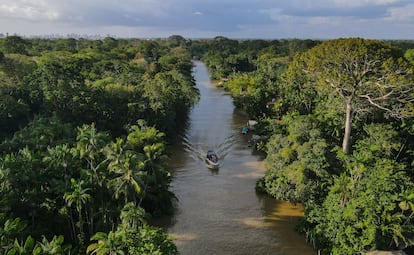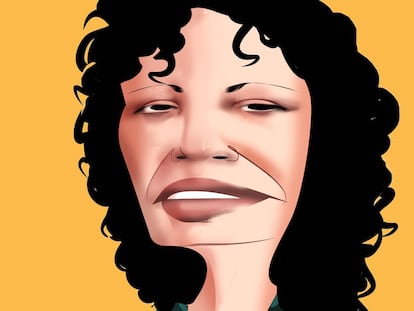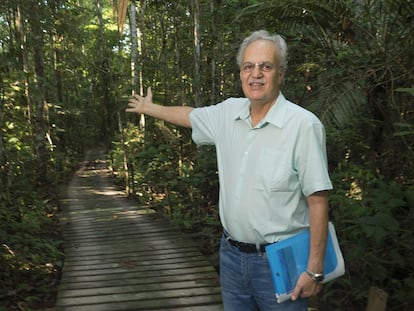Deforestation and expectations: presidents of Amazon nations attend summit in Belém do Pará, Brazil
While fewer trees are being chopped down in Brazil and Colombia, the rest of the region continues to spiral. The environmental summit will be a key event for the leaders of Peru and Venezuela, who will face each other on the international stage for the first time

Across all the territories that make up the Amazon regions, expectations are high. Between August 8 and 9, the presidents of the eight countries that each have part of the Amazon rainforest within their borders (along with some other associate leaders) will meet in Belém do Pará, Brazil. They plan on issuing a crucial statement to the world, about how they plan to prevent this region from reaching a point of no return and further affecting the climate.
It’s a political meeting, but also one that’s vital for humanity’s existence. Although the Amazon Cooperation Treaty Organization (OTCA) — an intergovernmental body that these countries constitute — was created at the end of the 1970s, this will only be the fourth time the national leaders have met. For this reason, it’s expected that after the declaration is released, the ACTO will also be strengthened in the international context. In fact, the results of this summit will be taken to the 78th session of the United Nations General Assembly — which is set to be held in September — and to the UN Conference on Climate Change (COP28), which will take place in the United Arab Emirates in early December.
EL PAÍS takes a look at the state of six of the eight Amazon countries that will be represented at the summit in Brazil.
Brazil: a renewed vision of the Amazon
The summit — conceived by President Luiz Inácio Lula da Silva — is a golden opportunity for Brazil to display its new vision of the Amazon to the world. This comes after years of climate change denial and accelerated deforestation by former President Jair Bolsonaro. President Lula has made his promise to achieve zero deforestation by 2030 one of the key elements of his foreign policy. In recent months, he has managed to get countries like Germany and Norway to, once again, contribute funds to the preservation of the biome. New Indigenous lands have also been demarcated, environmental police and controls have been increased in the Brazilian countryside, and a tough battle has been waged to expel thousands of garimpeiros (illegal gold prospectors) from Yanomami Indigenous territory, along the border with Venezuela.
In June, the Brazilian government updated the national plan to combat deforestation, which, in the 2000s, achieved notable results against illegal logging. The turnaround in environmental policy is beginning to be noticed: in the first half of this year, deforestation in the Amazon fell by 34%, with 1,022 square miles of jungle being saved. The preliminary data — captured with satellite images — will have to be confirmed at a later date, although this would imply that a downward trend started at the beginning of 2023.
Bolivia: deforestation and rising mercury levels
Bolivia’s Amazonian territory — which covers 8.1% of the total Amazon, or more than 2.7 million square miles — faces numerous problems. A major one is the growing presence of illegal mining, in which mercury is used to extract gold from rivers that supply water to Indigenous and peasant communities, putting their health and integral development at risk. Added to this is deforestation: in 2022, nearly one million acres of virgin forests were destroyed, 32% more than in 2021, according to a study by Global Forest Watch. The platform estimates that Bolivia is the country that loses the most virgin forests worldwide, along with Brazil.
The government of Bolivia has announced that, at the summit, it will propose a mechanism to bolster cooperation between presidents and Indigenous people, to overcome the risks that threaten the Amazon basin.
“With this mechanism, [we will] strengthen integration and cooperation, to take on the challenges that the region faces, [so that we may use the available resources] to assume the responsibilities and multilateral international commitments that Bolivia is party to,” stated Freddy Mamani, the Bolivian vice minister of foreign affairs.

Colombia: Deforestation decreases and government proposes saying “goodbye” to oil
This year, the news was good for the Colombian Amazon. According to figures provided by the Ministry of Environment, deforestation fell drastically in the country between 2021 and 2022. On the one hand, for the entire Amazon region of Colombia — which includes the departments of Amazonas, Guaviare, Guainía and Vaupés, and part of the departments of Putumayo, Caquetá, Nariño, Cauca, Meta and Vichada — the reduction in deforestation was 36% compared to the previous year. Meanwhile, in the Amazon arc — an area that includes parts of Guaviare, Caquetá, Meta and Putumayo, where logging has historically been concentrated — deforestation decreased by 26%.
With this encouraging scenario, Colombia is coming to the summit with several proposals. Some of these, according to Minister of Environment Susana Muhamad, are likely to end up in the final joint declaration made by the countries, such as including the importance of an Andean-Amazonian agenda, as well as the famous debt swap that President Gustavo Petro has spoken about on several occasions (which consists of protecting land in exchange for debt relief from the international community). However, Colombia has also presented a more controversial proposal — one that isn’t necessarily supported by the other governments — regarding the prohibition of the exploration and exploitation of oil or fossil fuels in the Amazon. While there are still several doubts and barriers for this measure to become part of the final declaration, the minister of environment affirmed that “Petro’s position is to encourage the Colombian congresspeople to [propose this legislation].”
Ecuador: on the edge
The government of Ecuador will attend the Amazon summit with its days numbered. On August 20, Ecuadorians will go to the polls to choose a new president. Citizens will also have the option of voting “yes” or “no” on a referendum, which asks the voting-age population if it wishes to extract the crude oil reserves from block 43-ITT, or leave the resources underground. The site is located in the most biodiverse reserve in the world called Yasuní, within the Amazon.
This consultation could open the door for people to decide on other oil and mining projects that affect the Indigenous populations of the Amazon, who already suffer the consequences of cutting down and burning trees, river pollution, diseases, armed groups and community clashes. Meanwhile, the government’s position has been to “extract every last drop of profit from our oil” as President Guillermo Lasso said in his address to the nation in 2022. While he is eligible for a second term, he is not standing as a candidate in the August elections.
However, Ecuador will go to the Amazon summit to propose just the opposite of this, asking that the entire region develop “projects that seek the conservation and sustainable use of biodiversity, the ecological transition and the protection of forests from all types of contamination by plastics,” according to Ecuador’s Ministry of Foreign Affairs. The government will also be seeking cooperation from the other nations in attendance to contend with one of the most devastating phenomena in the Amazon basis: forest fires.
Peru: the president’s first trip abroad
If, in 2020, Peru reached its highest deforestation peak in the last two decades — with 500,000 acres of forest having been cleared that year — 2022 further highlighted the seriousness of the matter. According to the Monitoring of the Andean Amazon Project (MAAP), the country lost 355,517 acres of primary forest last year, ranking third in the region, only behind Brazil and Bolivia.
Peru arrives at the summit with another warning sign: since 2020, 14 Indigenous leaders and environmental activists have been assassinated at the hands of drug traffickers, land traffickers and illegal miners. “It’s a very critical issue that reveals the vulnerability of those who protect our forests,” said Yvette Sierra, a Peruvian journalist from the specialized media outlet Mongabay Latam. She will be covering the summit in Belém do Pará.
The summit is also the first one abroad attended by President Dina Boluarte — the first female president of Peru — since she took office eight months ago, after receiving authorization from Congress. As she does not have a vice president to govern while she is away, the country’s Congress had to approve the trip, amid questions from certain opposition groups.
Minister of Foreign Affairs Ana Cecilia Gervasi has announced that the Peruvian government will present a “proposal for an Amazon with a human face,” while centering Indigenous people. For her part, Albina Ruiz, the minister of environment, has publicly warned of certain legislative initiatives being proposed in the Congress of Peru that could hurt Amazonian communities. One bill seeks to take away powers from her portfolio to enforce the Forest and Wildlife Law.
Venezuela: armed groups, illegal mining and human rights violations
Multiple armed groups, including guerrillas such as the ELN, illegal miners and criminal gangs control much of the Venezuelan Amazon, and they do so with the complicity of the country’s military, which engages in numerous illegal activities. This scenario is one of the greatest threats to the future of the ecosystem.
Three of the most violent municipalities in the country are in the south, in the state of Bolívar. Meanwhile, El Callao — the mining epicenter — has the highest homicide rate in the country. This situation has only worsened since the government of Nicolás Maduro established the Orinoco Mining Arc: a portion of land that is equivalent to 12% of the national territory, now fully dedicated to exploiting minerals.
Venezuela is experiencing an environmental crisis, with serious levels of deforestation, mercury contamination and loss of species. “[These are issues] that the region must face in a coordinated manner, since any one country cannot simply take action alone, as it would only displace the problem,” emphasized biologist Bibiana Sucre. She’s a member of the Amazon Georeferenced Socio-environmental Information Network, which is participating in the summit on the sidelines, as a part of civil society.
Venezuela has turned a blind eye to these problems for years. The crisis in the oil industry has forced the government to focus on mining. But since Maduro attended the COP27 last November, in Egypt, the issue has been incorporated into his rethoric. A few months ago, he ordered an operation to evict 25,000 people living in illegal mining camps from the Yapacana National Park, in the state of Amazonas. In July, Maduro declared that “the advance of illegal mining has been destroying the Amazon of South America and Venezuela,” heating up the narrative for the Amazon summit. However, despite this, the position of the Venezuelan government isn’t clear. Attending the meeting is part of the Chavista leader’s return to international forums, after a years-long diplomatic siege, imposed due to the democratic, economic and humanitarian crises in his country. The summit is key in Maduro’s search to access multilateral financing.
Sign up for our weekly newsletter to get more English-language news coverage from EL PAÍS USA Edition
Tu suscripción se está usando en otro dispositivo
¿Quieres añadir otro usuario a tu suscripción?
Si continúas leyendo en este dispositivo, no se podrá leer en el otro.
FlechaTu suscripción se está usando en otro dispositivo y solo puedes acceder a EL PAÍS desde un dispositivo a la vez.
Si quieres compartir tu cuenta, cambia tu suscripción a la modalidad Premium, así podrás añadir otro usuario. Cada uno accederá con su propia cuenta de email, lo que os permitirá personalizar vuestra experiencia en EL PAÍS.
¿Tienes una suscripción de empresa? Accede aquí para contratar más cuentas.
En el caso de no saber quién está usando tu cuenta, te recomendamos cambiar tu contraseña aquí.
Si decides continuar compartiendo tu cuenta, este mensaje se mostrará en tu dispositivo y en el de la otra persona que está usando tu cuenta de forma indefinida, afectando a tu experiencia de lectura. Puedes consultar aquí los términos y condiciones de la suscripción digital.
More information
Archived In
Últimas noticias
Most viewed
- Sinaloa Cartel war is taking its toll on Los Chapitos
- Oona Chaplin: ‘I told James Cameron that I was living in a treehouse and starting a permaculture project with a friend’
- Reinhard Genzel, Nobel laureate in physics: ‘One-minute videos will never give you the truth’
- Why the price of coffee has skyrocketed: from Brazilian plantations to specialty coffee houses
- Silver prices are going crazy: This is what’s fueling the rally










































